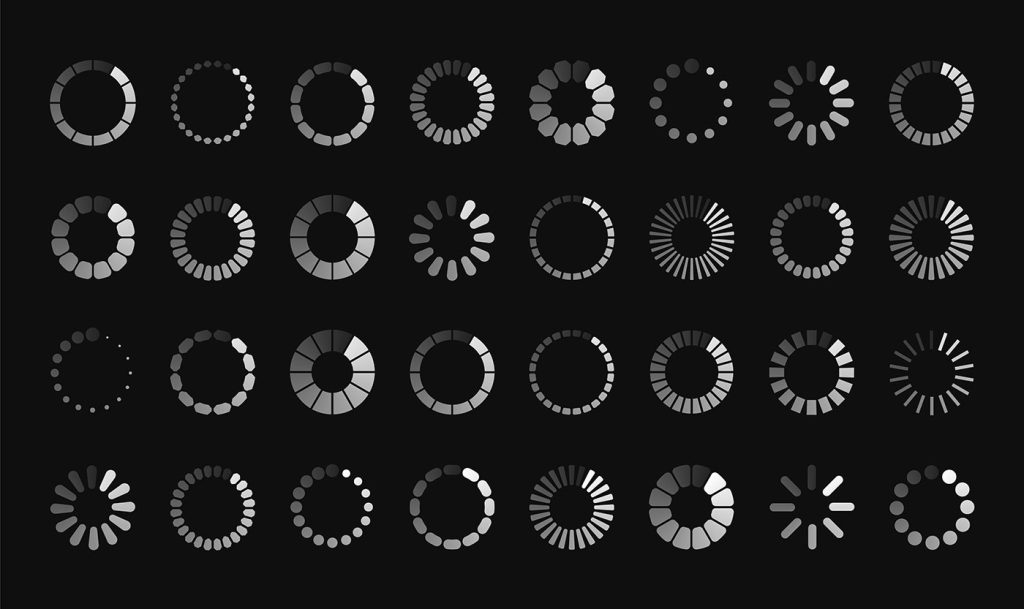There’s always that one big problem in art school, where you spot a few fellow students that you know “have it!” They don’t need to learn anything because they came into school with “it.” Still, they sit there and continue to have their brilliance illuminate the mediocrity that surrounds them. You knew they were destined for greatness. The rest of us hated them.
Chris Reed was one of those guys. He was actually a designer and illustrator, which just doubles my jealous rage, although he’s still a damn humble, nice guy. Apply one-point-two-one gigawatts, Marty and we go back to those days: it was a cartooning class taught by Harvey Kurtzman. So, Chris walks in, with a small pad of paper and his damn pouch of magic pens. Oh, he’d pull out one of his rapidograph pens of power and BANG! He had drawn a brilliant cartoon within a few minutes.
One of Chris’ art school drawings. As you see examples of his past and current work, you will notice a style in his approach to layout and spacial relationships.
I don’t remember why the rest of us let him live, but he does live, so I asked him a few questions and he graciously answered them all.
In art school, I was always impressed that you were so comfortable with your drawing style. While other students were trying to find a “look” that defined them, you obviously had it down and have continued with more or less the same look to your art. When did you first start drawing with the simple line style and look you had back then?
I started drawing with a simple line style when I got my first rapidograph in 8th grade. I was fascinated by the tiny illustrations in the margins of Mad magazine by cartoonist Sergio Aragones. I naively thought that they were drawn at that tiny size so I tried to keep my drawings simple in order to draw as small as possible. As I started drawing larger and adding color, I began using heavier weight lines to help contain the watercolor wash or marker color inside the lines.
Yes, I see that now. Your smaller pieces were great. They were simplicity at it’s best. I always loved the line a Rapidograph would give your work. I tried Rapidographs, too. Loved the line but the teachers kept insisting it was a drafting tool and beating me for not being “attractive.”
Your work has gotten a bit slicker, if that’s a good descriptor. Are you using the same drawing tools or have you switched to the computer? How has that affected your work and do you prefer it? Are you comfortable with it?
These days I use a pretty bold line when inking in my pencil sketches. I scan the drawing into the computer and apply my color in Adobe Illustrator. I will also trace my pencil sketches with the pen tool in Illustrator for a tighter, more graphic look. I love creating art on the computer, it’s a forgiving medium and gives you a lot of flexibility.
I don’t want to remember the days before Adobe CS! How soon after art school before your first professional project… or were you still in school when you did one?
I was getting a little bit of work while I was in school, but it was obviously odd, low profile stuff. I had an ongoing gig with a handbag showroom doing line drawings of women’s purses for their sell sheets. Not very portfolio worthy, but it was good money for a student. I sold my first cartoon to Playboy while I was still in school which was exciting for me.
Well, you see — it’s rare for a student to have an illustration job AND sell a cartoon to Playboy, which was considered the top of the market at that time, along with the New Yorker at the other end of the two top publications with cartoons… and MAD Magazine somewhere in there but I don’t want to try to consider how far left or right it is to one of the other magazines. Would you show pieces from art school in your portfolio or do you feel they are not good representations of what you do now?
I had student pieces in my portfolio for a number of years, but they gradually gave way to real jobs that I could put in my portfolio as tear sheets. We actually sat down with art directors back then while they thumbed through our books, so it was important to show that we had actual experience and a narrative on how we worked.
Did you have confidence in your abilities in art school and knew you were destine to be a great illustrator or did you have doubts that your drawing style would be acceptable to clients at that time?
Coming out of art school, I had confidence in my abilities, but I didn’t really know if I could pull off a career in illustration. I had majored in graphic design, so that was available fall back position and I had part time job as a production artist that was paying my bills. Having a small income gave me enough of a cushion to keep plugging away until I had enough work coming in to go with freelance illustration 100%. It took me almost 2 years before I felt confident enough to take the leap.
Still, that was then. Two years to strict freelance wasn’t bad at all. Freelancing in illustration is almost impossible these days except for the lucky few. Do you feel your work stays fresh? Are you still comfortable with your drawing style or have you ever thought that you’d like to explore another medium or tools for your drawing?
I’m very comfortable with my drawing style, but I do try to tweak it here and there to keep it looking fresh. My core drawing tools have remained the same, pencils and pens, and the computer allows me to add a little variety to my look. Working digitally has brought me full circle back to graphic design, which has been fun. When I create art for product applications, I get to design the look of a product and provide the illustration.
The concept of “style” is confusing to most illustration students. What advice would you give students seeking to find a “look” that defines them and how they can find it within themselves?
Acquiring a style is something that often evolves slowly. You draw or paint a lot, you sample other artist’s styles whose work you admire, it all gets churned up in the mix, and hopefully something new and marketable comes out. My advice to finding a look is to crank out a lot of art with different mediums and tools. Something will click, and hopefully you’ll keep gravitating to it until you get to the point where you feel you own it.
Yeah, but you were IN art school by the time the experimentation part of creative development was over. Did teachers encourage you to continue with the tools you used back then or try to convince you to explore other mediums and tools? If yes, what were your thoughts at the time?
I was a design major, so I only took a limited number of illustration classes in art school. Those classes were cartoon oriented, as a result I didn’t have instructors pushing me in new directions. My cartoon style was already pretty solid, it was legible, and moderately funny.
Well, those few classes had some heavy hitters in the illustration/cartooning world. Who were the illustrators that inspired you back then? Who inspires you now and why?
Artists that inspired me back then were guys like Lou Brooks, Elwood Smith, Kurt Vargo, Seymour Chwast, Moebius, Herge… lots of guys. Lou and Kurt were both teachers of mine at SVA and encouraged me to go out and give illustration a shot. Some of my favorite these days are Jean Tuttle, Robert Saunders, Chris Gash, Sean Kelly, Dave Klug… too many to mention. I admire anybody who consistently pairs a beautiful style with smart concepts.
It wasn’t, however, just Chris’ talent that propelled him forward as an illustrator. It was hard work to get that talent in front of the right people. He had drive and confidence and a purpose that he obviously felt at a very young age and most of us had to catch up once the lessons of art school sunk into our heads. It takes some longer than others but, as with Chris, when it hits you, it sticks.
Another interesting consideration is Chris’ study of design and illustration. When I think about it, the best illustrators I’ve ever known were also talented designers and the most talented designers I ever knew were talented illustrators. Some of them were also talented photographers and musicians. God… how I hate them all!
Did you know someone like this in art school? Did know they were going to make it in the industry without a doubt or did they end up in the gutter, where you walked by and laughed? Did this example make you think about your career and moving it forward? Let us know in the comments.














